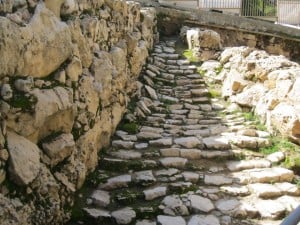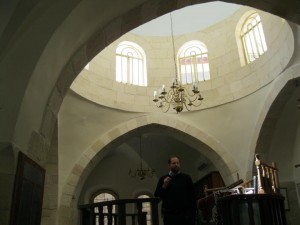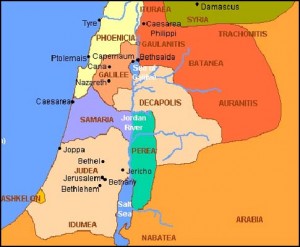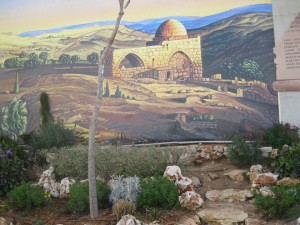Jewish History in a Nutshell: Hebron
Hebron hosts the oldest Jewish community in the world and is the second holiest city in the Jewish religion after Jerusalem.
Hebron is the second holiest city in the Jewish religion. In Hebrew, the name Hebron comes from the Hebrew word Haver meaning friend, while in Arabic the city is referred to as Beit al Chalil, which translates into House of the Beloved. This name is fitting for the city, for Hebron is the resting place of all of Israel’s beloved patriarchs, as well as most of Israel’s matriarchs, and Avraham, the first Jewish patriarch, is considered a friend of G-d, the creator of the universe.
Hebron in Antiquity
Hebron is mentioned 87 times in the Tanakh or Hebrew Bible. Genesis 23 speaks about how Avraham purchased a burial tomb within Hebron for his wife Sarah. Known as the Tomb of the Patriarchs, Avraham, Yitzhak, Rivka, Ya’akov and Leah are all buried there. Rachel the wife of Ya’akov is buried in Bethlehem. Jewish tradition also maintains that Adam and Eve are buried in the same location. Hebron was also one of the first places that Israel’s patriarchs resided upon arrival in Canaan. This implies that Hebron hosts the oldest Jewish community on the planet.
Upon the conquest of Canaan, Joshua assigned Hebron to the tribe of Judah. After the death of King Saul, King David ascended to Hebron, from where he was anointed king and ruled Israel for seven years, until he succeeded to conquer Jerusalem and proclaim the holy city to be the eternal capital of the Jewish people. During Second Temple times (around 20 BCE), King Herod built a structure over the Tomb of the Patriarchs which is partially still standing to date. During the Jewish revolt against Rome (around 130 BCE), Hebron was the scene of extensive fighting between the Jewish people and the Roman authorities. However, Jews continued to live in Hebron continuously during the Byzantine and Arab periods. There is even archaeological evidence for the existence of Byzantine-era synagogues in Hebron and travelers’ reports testify to the existence of a Hebron Jewish community under Arab rule.
Hebron in the Medieval Period
 However, when the Crusaders invaded the Holy Land, the ancient Jewish community of Hebron was expelled from their homes. According to Benjamin of Tuleda, who traveled to Israel in 1170, Hebron was completely destroyed due to the fighting that occurred between the Crusaders and the forces of Saladin. He describes in his book
However, when the Crusaders invaded the Holy Land, the ancient Jewish community of Hebron was expelled from their homes. According to Benjamin of Tuleda, who traveled to Israel in 1170, Hebron was completely destroyed due to the fighting that occurred between the Crusaders and the forces of Saladin. He describes in his bookThe Travels of Benjamin, “Here is a large church, called St. Abraham; and it was, when the country was still in possession of the Ishmaelites, a Jewish Synagogue.” However, by the time of Nachmanides, 1267, some Jews were reported to have returned to Hebron. Yet in 1517, Hebron’s Jews would suffer significantly from a violent pogrom which included mass murder, rape, and the plundering of Jewish homes.
Nevertheless, by 1540, when Rabbi Jechiel Ashkenazi visited Hebron, there was a sizable community of Karaite Jews, who had their own synagogue. That same year, Sephardic Jewish exiles from Spain would immigrate to Hebron and establish the famous Avraham Avinu Synagogue, which still exists in Hebron to date. The synagogue was given this name because a legend reports that once when a minyan was lacking within the synagogue, the patriarch Avraham appeared inside the synagogue in person in order to make up for it.
Hebron in the Modern Era
 In 1775, the Hebron Jewish community would suffer from a blood libel accusation, where local Jews were falsely accused of murdering a local sheikh and were forced to pay significant blood money as a result, which adversely affected the economic situation of the Hebron Jewish community. Nevertheless, throughout the Ottoman Turkish period, Jews from throughout the Diaspora and other parts of the Land of Israel would relocate to Hebron, which was one of the main centers of Jewish scholarship in Israel prior to the rise of Zionism. This ancient Jewish community would continue to exist in Hebron up until the 1929 massacre, during which sixty-seven people were murdered and the rest were forcefully expelled from the city. Jews would not be able to return to Hebron until after the 1967 war.
In 1775, the Hebron Jewish community would suffer from a blood libel accusation, where local Jews were falsely accused of murdering a local sheikh and were forced to pay significant blood money as a result, which adversely affected the economic situation of the Hebron Jewish community. Nevertheless, throughout the Ottoman Turkish period, Jews from throughout the Diaspora and other parts of the Land of Israel would relocate to Hebron, which was one of the main centers of Jewish scholarship in Israel prior to the rise of Zionism. This ancient Jewish community would continue to exist in Hebron up until the 1929 massacre, during which sixty-seven people were murdered and the rest were forcefully expelled from the city. Jews would not be able to return to Hebron until after the 1967 war.
Presently Hebron is home to a strong Jewish community centered around the Tomb of the Patriarchs and during the time of the weekly Torah portion of Hayai Sarah, thousands of Jews make the yearly pilgrimage to Hebron in order to the be close to the resting place of Sarah the great Jewish matriarch .
Featured in: http://www.jewishpress.com/blogs/united-with-israel/jewish-history-in-a-nutshell-hebron/2013/06/03/

According to the Israeli historian Benny Morris, in ancient times, “The core of the Jewish state was the hill country of Judea, Samaria, and Galilee.” Areas in mainland Israel such as Caesarea, Jaffa, and Ashkelon were centers of paganism in the Hellenistic and Roman periods and did not make up the heart of biblical Israel. Yet despite these historical facts, too many people support relinquishing Israeli control over Judea & Samaria, even though the area is richer in Jewish history than Arab history.
Yoram Ettinger, a consultant at the Ariel Center for Policy Research, asserted, “Many world-renowned travelers, historians and archeologists of earlier centuries refer to “Judea and Samaria,” while the term “West Bank” was coined only 60 years ago. Jordan gave the region this name when it occupied it after Israel’s War of Independence. No nation on earth other than Britain and Pakistan recognized Jordan’s claim to Judea and Samaria. […] Even the Encyclopedia Britannica, as well as official British and Ottoman records until 1950, used the term Judea and Samaria, and not the West Bank.”
 Ettinger claims that most Palestinian Arabs only came to live in the land of Israel within the last 150 years. He asserted, “Most Palestinian Arabs are descendants of the Muslim migrants who came to the area between 1845 to 1947. Arab migrant workers were imported by the Ottoman Empire and by the British Mandate (which defeated the Ottomans in 1917) for infrastructure projects. […] Illegal Arab laborers were also attracted by the relative economic boom in British Mandate Palestine, stimulated by Jewish immigration.” In addition, Egyptians came to the Holy Land following Muhammed Ali’s invasion of Israel between 1831 and 1840; and Algerians also arrived in Israel in order to escape the French conquest of their homeland in 1830.
Ettinger claims that most Palestinian Arabs only came to live in the land of Israel within the last 150 years. He asserted, “Most Palestinian Arabs are descendants of the Muslim migrants who came to the area between 1845 to 1947. Arab migrant workers were imported by the Ottoman Empire and by the British Mandate (which defeated the Ottomans in 1917) for infrastructure projects. […] Illegal Arab laborers were also attracted by the relative economic boom in British Mandate Palestine, stimulated by Jewish immigration.” In addition, Egyptians came to the Holy Land following Muhammed Ali’s invasion of Israel between 1831 and 1840; and Algerians also arrived in Israel in order to escape the French conquest of their homeland in 1830.
To the contrary, Jews have a history in Judea & Samaria dating back from time immemorial. For instance, Shechem, otherwise known as Nablus, has Jewish history dating back to Abraham. Shechem was the first place that Abraham set foot in when he arrived in Israel. Shechem is also the city where Jacob and his family settled after returning from Paddam Aram. Some historians such as Robert Wolfe and Paul Johnson, after studying archeological evidence coming out of Egypt, believe that there was a Jewish kingdom based in the area of Shechem while most Jews were slaves in Egypt. Regardless whether one believes them or not, Shechem is the resting place of Joseph, King David wrote about Shechem in the Book of Psalms, and King Rehoboam, who ruled the ten northern tribes of Israel following King Solomon’s death, initially made Shechem his capital city.
 Bethlehem is the city where the Jewish matriarch Rachel is buried, where the famous convert to Judaism Ruth married Boaz, and was the birthplace of King David. It is mentioned 44 times in the Tanakh. Hebron, which until the 1929 massacre briefly interrupted the Jewish presence in the city, had an ancient Jewish community. It is one of the four holiest cities in the Jewish religion. It is the place where the Cave of the Patriarchs is located, which contain the remains of Sarah, Abraham, Isaac, Rebecca, Jacob, and Leah. Jews also believe that Adam and Eve are buried there. Hebron is also the city where King David was anointed king and ruled for seven years prior to the conquest of Jerusalem.
Bethlehem is the city where the Jewish matriarch Rachel is buried, where the famous convert to Judaism Ruth married Boaz, and was the birthplace of King David. It is mentioned 44 times in the Tanakh. Hebron, which until the 1929 massacre briefly interrupted the Jewish presence in the city, had an ancient Jewish community. It is one of the four holiest cities in the Jewish religion. It is the place where the Cave of the Patriarchs is located, which contain the remains of Sarah, Abraham, Isaac, Rebecca, Jacob, and Leah. Jews also believe that Adam and Eve are buried there. Hebron is also the city where King David was anointed king and ruled for seven years prior to the conquest of Jerusalem.
These are but a few of the many examples of Jewish history in Judea & Samaria. Furthermore, almost all of the Arab localities in Judea & Samaria have retained biblical Jewish names, thus betraying the true Jewish roots in the area. Given all of these facts, to deny the Jewish connection to Judea & Samaria is to deny the historic reality.
No comments:
Post a Comment